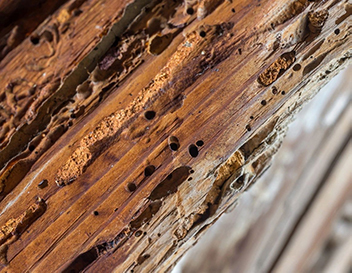Wood Destroying Insect Control In Auckland
Need help? Call us now!
NZ Pest Control offers pest control treatments for Auckland home and commercial premises. Contact us for a free quote today.
NZ Pest Control - Your Pest Control Specialists!
What Our Customers Say
Collected through Google My Business


What is a Wood Destroying Insect?
Borer Beetles belong to the insect order Coleoptera. This name comes from the Greek ‘koleos’ for sheath and ‘pteron’ for wing, and refers to their hardened front wings – called elytra. The elytra meet along the midline of the body, enclosing and protecting the abdomen, and giving beetles their characteristic appearance.
The elytra, an armoured exoskeleton and a compact body allow beetles to live where other insects with more delicate or exposed wings would be damaged – when burrowing in leaf litter or soil, for example. These features also protect beetles from attacks. The elytra help prevent water loss by covering the openings to the breathing tubes on the abdomen.
The flight holes are approximately 2mm in diameter for Common House Borer, 3-4mm for Native House Borer, and up to 7mm and more oval in shape for Two Toothed Longhorn Borer.
The New Zealand drywood termite occurs throughout New Zealand. In buildings, conditions favouring development of drywood termites also suit the larvae of two- toothed longhorn and house borer beetles, so it is rare for drywood termites to be the sole deteriorating agent. However, the presence of even small nests can cause areas of structural weakness. In addition, because exit holes are inconspicuous and few in number, the damage may remain undetected and become widespread in the building before the need for remedial action is realised. Buildings closely surrounded by neglected shelter trees may be more susceptible to damage than others.
Why do I have them?
It is not uncommon, to have wood destroying insects attack some boards and not others – the untouched ones are probably harder heart wood.
Are they dangerous?
Wood destroying insects are not harmful to humans, however they can cause structural damage and weakness to areas of your home or building if left untreated.
How do I get rid of wood destroying insects?
Getting rid of wood destroying insects can be a difficult task due to the territorial behaviour. NZ Pest Control is your one-stop company for eradication of pest bird problems. Our highly trained pest control professionals will make a thorough inspection of your property and then create a custom designed solution to rid your property of pest birds in the quickest and safest manner possible.
Can I do it myself?
Do-It-Yourself methods to control wood destroying insect damage is often not successful as it takes a trained eye to know just how and where to treat for these pests.
Let us help you
How soon can you get here?
At NZ Pest Control, we strive to give our customers a rapid, efficient service, and make every effort to be with you as soon as possible.
Is the treatment safe?
All products used by NZ Pest Control, must have first been thoroughly checked by the EPA and registered for pest control use. Only then can they be considered for use by our highly trained pest control professionals. You can be assured that pest control services provided by NZ Pest Control will not cause any harm to humans or pets.
How can I prevent wood destroying insects in the future?
The most successful control of infestations involves the removal of affected timbers and their replacement with those treated with preservatives. This is especially desirable if principal structural timbers are affected and where there is risk of re-infestation from surroundings.







